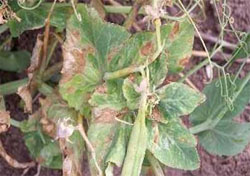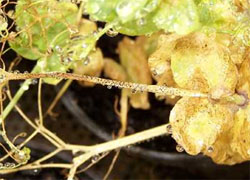Septoria blotch of field pea
Septoria blotch of field peas is usually a minor disease occurring sporadically in Victoria and South Australia but has caused major crop losses in NSW.
The disease is often seen on senescing plants late in the growing season. The disease can be prevented by stubble management and crop rotation.
What to look for
The disease is mainly found on the lower, senescing parts of the plant and pods. Diseased areas on leaves are of indefinite size and shape and are yellow then straw coloured to light brown (see Figure 1), often with a lighter centre and a pale yellow halo on the margin

Several such blotches may join together to cover the entire leaf. Within the lesions, pin-point sized black fruiting bodies of the fungus may be seen. Diseased tissues may dry off prematurely.
Disease cycle
Septoria blotch is caused by the fungus Septoria pisi.

The fungus survives from one season to the next on infected pea trash and seed. Spores of the fungus are carried by wind from infected trash, into the new crop.
Infection is found on the lower foliage where the humidity is high following rain or heavy dews. The disease is favoured by warm temperatures (21 to 27°C) and extended periods of high humidity.
Secondary spread occurs during the growing season. Rain splash assists in spreading the disease within a crop. Whilst seed transmission can occur it is unlikely to be important.
Economic importance
The disease occurs in most pea growing regions but seldom causes significant yield losses. In susceptible pea varieties, grain yield losses of up to 40 per cent have been reported.
Management
Septoria can be controlled by destroying infected stubble and by crop rotation.
Crop rotation
The septoria blotch fungus survives in soil and on old pea trash. It is only safe to re-crop an area with peas after all pea debris has decomposed.
Destroying pea stubble by grazing, burning and cultivation will help in reduce the amount of inoculum available to infect new crops.
A break of at least 2 years between successive field pea crops will minimise the risk of disease carry over.
Variety
Nearly all field pea varieties are moderately susceptible to septoria, however, the disease appears to be most severe on the short, semi-leafless varieties.
Chemical control
No foliar or seed applied fungicides are registered for use on septoria in field peas in Victoria.
Further references
- Pulse Australia
- National Variety Trials
- Field Pea Southern Region - GrowNotes
- Victorian Winter Crop Summary
- Victorian Pulse Disease Guide
- Seed Health Testing in Pulse Crops
- Pulse Seed Treatments and Foliar Fungicides
Contact
Dr Joshua Fanning
Pulse Pathologist - Horsham
0419 272 075
Field Crops Pathology
Grains Innovation Park
110 Natimuk Rd
Horsham 3400
(03) 4344 3111
Or call the Customer Service Centre, 136 186
Acknowledgments
Trevor Bretag, Helen Richardson, Frank Henry. Support by the Grains Research and Development Corporation is gratefully acknowledged.